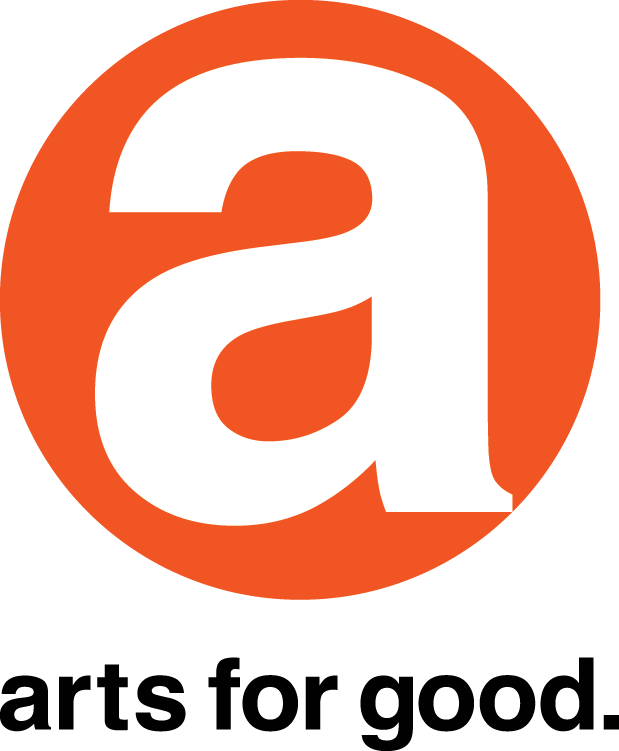Winter 2018 Student Presentations

In the spirit of civic and cultural engagement, artworxLA students presented artworks inspired by monuments and memorials, utopian and dystopian visions of the future, community journalism and activism this winter. Three public presentations at the Autry Museum of the American West, Central Library in Downtown LA, and the Japanese American National Museum (JANM) exhibited how, through a creative lens, students can expand depth of knowledge, develop technical skills, and demand change in their communities.
A special thank you to our cultural partners, school partners, artworxLA staff, and Teaching Artists for supporting our students’ creative journey. Thank you also to the special guests and supporters who attended the event including: Arts for Incarcerated Youth Network, Los Angeles County Probation (Van Nuys JDRC), LA Promise Fund, the University of Southern California, CBS2/KCAL9, and Telemundo.
Autry Museum of the American West | Voices of A Movement: LA Raza and Community Journalism
Photos by Frankie Reyes and Paul Ulukpo


In ten weeks students from Bermudez in Pico Rivera, experimented with a multiplicity of materials and forms; shooting 16mm Film, Polaroid 600 film, Music Video Effects, Music making Apps, HD videos, Sun Prints, Chicano videos, and lots of donuts. We produced a myriad of videos from Green Screen, Freestyling on Video, to YouTube reactions, inspired by the theme of community journalism.

Jonas Salk students focused on Community Belonging, and Strengths and Struggles to guide there art making. After exploring imagery and topics from La Raza publication, the Chicano/a and contemporary community movements, each student completed an individual community map. The maps were the foundation for their final paper sculpture ‘installation.’ Students worked individually and collaboratively to create sculptures that reflected their personal relationship to all or one of the topics of Belonging, Strengths and Struggles. The final ‘installation’ is the combination of all the students’ artwork to be viewed as one community where all the students, and their strengths and struggles, belong.

At Visions we explored the work of revolutionary La Raza artists and activists. We engaged in group discussions, viewing of subversive publications, writing exercises and one-on-one interviews as well as viewed the legendary ZOOT SUIT and had the original female lead, Rose Portillo, come as a guest artist. Participants created written and some visual pieces exploring the theme of LA RAZA culminating in a published chapbook.

Jonas Salk students focused on Community Belonging, and Strengths and Struggles to guide there art making. After exploring imagery and topics from La Raza publication, the Chicano/a and contemporary community movements, each student completed an individual community map. The maps were the foundation for their final paper sculpture ‘installation.’ Students worked individually and collaboratively to create sculptures that reflected their personal relationship to all or one of the topics of Belonging, Strengths and Struggles. The final ‘installation’ is the combination of all the students’ artwork to be viewed as one community where all the students, and their strengths and struggles, belong.

Using zines, graphic novels/comics and storytelling, our workshop explored artistic and creative tools as a way to participate in community building. At each workshop, we took time to practice drawing and trying out new methods such as graphite transfer paper, rubbings and tracing. These exercises served as an entry point with which we could talk about art and creative means of practicing social justice. We also looked at photos and videos from the Chicano moratorium, Ferguson, the Black Lives Matter movement, and discussed what has and has not changed. At each workshop, we warmed up by doing exercises and activities with each other to practice working with the concepts of self- publications, storytelling and zine/bookmaking. The students learned how to make a variety of different zines and artists’ books including the concertina style. We enjoyed looking at several publications featured in the La Raza exhibition as well as more contemporary zines and publications. Legacies of empowerment, interdependence and resilience grounded how we approached each workshop and project. Our final project was a self-produced zine and collages made utilizing imagery from the Chicano moratorium news footage and documentation.

In ten weeks students from Bermudez in Pico Rivera, experimented with a multiplicity of materials and forms; shooting 16mm Film, Polaroid 600 film, Music Video Effects, Music making Apps, HD videos, Sun Prints, Chicano videos, and lots of donuts. We produced a myriad of videos from Green Screen, Freestyling on Video, to YouTube reactions, inspired by the theme of community journalism.


Students created works of art over the course of 10 weeks, inspired by the theme Voices of Movement: LA RAZA and Community Journalism through critical dialogue addressing notions of personal identity in engaging with issues of public concern, and various options to be active: voting, protests, signing petitions, dialogue, magazines, “zines” journalism, social media, and art making. Students explored visually how they could promote and educate people, community, and family by engaging in discussing the Chicano/a history of Los Angeles. The students made a self portrait silhouette and explored common issues or a cause in their own life.
Among the many topics discussed within the theme students addressed personal concerns in their own families or life situations, and created art using photographic images from LA Raza exhibition. The images express how they personally feel about the current topic of racism and hatred towards them; immigration, and students’ concern about their parents’ status; police brutality in their community; peace and war, not only globally, but crime and violence in their own community; education, the access and important value of higher learning.
Overall, students learned that they are important and that their voices matter, and different collage techniques and art styles; monoprinting, design, sketching, urban art, campaign art, advertising and experimentation.

Students created works of art over the course of 10 weeks, inspired by the theme Voices of Movement: LA RAZA and Community Journalism through critical dialogue addressing notions of personal identity in engaging with issues of public concern, and various options to be active: voting, protests, signing petitions, dialogue, magazines, “zines” journalism, social media, and art making. Students explored visually how they could promote and educate people, community, and family by engaging in discussing the Chicano/a history of Los Angeles. The students made a self portrait silhouette and explored common issues or a cause in their own life.
Among the many topics discussed within the theme students addressed personal concerns in their own families or life situations, and created art using photographic images from LA Raza exhibition. The images express how they personally feel about the current topic of racism and hatred towards them; immigration, and students’ concern about their parents’ status; police brutality in their community; peace and war, not only globally, but crime and violence in their own community; education, the access and important value of higher learning.
Overall, students learned that they are important and that their voices matter, and different collage techniques and art styles; monoprinting, design, sketching, urban art, campaign art, advertising and experimentation.

Students created works of art over the course of 10 weeks, inspired by the theme Voices of Movement: LA RAZA and Community Journalism through critical dialogue addressing notions of personal identity in engaging with issues of public concern, and various options to be active: voting, protests, signing petitions, dialogue, magazines, “zines” journalism, social media, and art making. Students explored visually how they could promote and educate people, community, and family by engaging in discussing the Chicano/a history of Los Angeles. The students made a self portrait silhouette and explored common issues or a cause in their own life.
Among the many topics discussed within the theme students addressed personal concerns in their own families or life situations, and created art using photographic images from LA Raza exhibition. The images express how they personally feel about the current topic of racism and hatred towards them; immigration, and students’ concern about their parents’ status; police brutality in their community; peace and war, not only globally, but crime and violence in their own community; education, the access and important value of higher learning.
Overall, students learned that they are important and that their voices matter, and different collage techniques and art styles; monoprinting, design, sketching, urban art, campaign art, advertising and experimentation.











Posters of Protest - Everyone has a Voice
This workshop addressed the role that protest art played in the development of the Chicano/a movement in relation to the historical legacy of La Raza (1967-1977) a bilingual magazine that documented and was the voice of the social political movement of the 60's in LA.
Students were asked to explore what it would "feel" like to participate in or be part of a social, cultural, political and artistic movement. The concept being how movements are created and supported by consciousness, cultural pride, a desire for social justice, activism, identity and courage.
Students selected key current day issues that affect them in order to create their own individual protest poster. Each poster reflects a key focal point image as well as a protest slogan or statement and were painted in acrylics on canvas.
The protest posters reflect the personal sentiment of each student, addressing a deep concern that would give them an avenue to “find their voice” through their protest statement and art, so as to create empathy with past historical movements, and to bridge and experience the motivation it requires in a present day movement of speaking up, in terms of change and equality.


Posters of Protest - Everyone has a Voice
This workshop addressed the role that protest art played in the development of the Chicano/a movement in relation to the historical legacy of La Raza (1967-1977) a bilingual magazine that documented and was the voice of the social political movement of the 60's in LA.
Students were asked to explore what it would "feel" like to participate in or be part of a social, cultural, political and artistic movement. The concept being how movements are created and supported by consciousness, cultural pride, a desire for social justice, activism, identity and courage.
Students selected key current day issues that affect them in order to create their own individual protest poster. Each poster reflects a key focal point image as well as a protest slogan or statement and were painted in acrylics on canvas.
The protest posters reflect the personal sentiment of each student, addressing a deep concern that would give them an avenue to “find their voice” through their protest statement and art, so as to create empathy with past historical movements, and to bridge and experience the motivation it requires in a present day movement of speaking up, in terms of change and equality.


Students created works of art over the course of 10 weeks, inspired by the theme Voices of Movement: LA RAZA and Community Journalism through critical dialogue addressing notions of personal identity in engaging with issues of public concern, and various options to be active: voting, protests, signing petitions, dialogue, magazines, “zines” journalism, social media, and art making. Students explored visually how they could promote and educate people, community, and family by engaging in discussing the Chicano/a history of Los Angeles. The students made a self portrait silhouette and explored common issues or a cause in their own life.
Among the many topics discussed within the theme students addressed personal concerns in their own families or life situations, and created art using photographic images from LA Raza exhibition. The images express how they personally feel about the current topic of racism and hatred towards them; immigration, and students’ concern about their parents’ status; police brutality in their community; peace and war, not only globally, but crime and violence in their own community; education, the access and important value of higher learning.
Overall, students learned that they are important and that their voices matter, and different collage techniques and art styles; monoprinting, design, sketching, urban art, campaign art, advertising and experimentation.














Posters of Protest - Everyone has a Voice
This workshop addressed the role that protest art played in the development of the Chicano/a movement in relation to the historical legacy of La Raza (1967-1977) a bilingual magazine that documented and was the voice of the social political movement of the 60's in LA.
Students were asked to explore what it would "feel" like to participate in or be part of a social, cultural, political and artistic movement. The concept being how movements are created and supported by consciousness, cultural pride, a desire for social justice, activism, identity and courage.
Students selected key current day issues that affect them in order to create their own individual protest poster. Each poster reflects a key focal point image as well as a protest slogan or statement and were painted in acrylics on canvas.
The protest posters reflect the personal sentiment of each student, addressing a deep concern that would give them an avenue to “find their voice” through their protest statement and art, so as to create empathy with past historical movements, and to bridge and experience the motivation it requires in a present day movement of speaking up, in terms of change and equality.

Students at SAITO created collages using photos from La Raza publication, a bilingual newspaper that became the voice of the Chicano/a movement from the late 1960s and 1970s. The collages were then use to make a screen print, expressing messages about immigration, DACA, social justice, racism, violence and more.
Using some of the exact techniques that were used to create the “zine”, we cut and pasted images together to create a layout for the screen prints. Then, students identified issues that matter to them now, that were equally important to the youth from the Chicano/a movement. Using screen-printing as the medium, students created images and slogans to print over the collage with the hope to show a connection between the past and present. Finding that not much has changed in the span of 50 plus years.



Los Angeles Public Library | Into the Unknown: Sci-Fi Visions of the Future
Photos by Chris Devlin and Paul Ulukpo


Students have looked at the history of Sci-fi in film, literature, inventions and in visual art through the artwork of artist Mahony Nagy. Following his philosophy to integrate art, technology and education for the betterment of humanity. We explored the value of new ways of seeing through technologies such as artificial intelligence and space photography from the Hubble.
Artworks were created with industrial materials such as plexiglass that was incised, painted and spray painted creating different forms and layers through stenciling.
Optical illusion, perspective and divine symmetry were introduced throughout this course in order to plan out the final composition.


Students have looked at the history of Sci-fi in film, literature, inventions and in visual art through the artwork of artist Mahony Nagy. Following his philosophy to integrate art, technology and education for the betterment of humanity. We explored the value of new ways of seeing through technologies such as artificial intelligence and space photography from the Hubble.
Artworks were created with industrial materials such as plexiglass that was incised, painted and spray painted creating different forms and layers through stenciling.
Optical illusion, perspective and divine symmetry were introduced throughout this course in order to plan out the final composition.


Students have looked at the history of Sci-fi in film, literature, inventions and in visual art through the artwork of artist Mahony Nagy. Following his philosophy to integrate art, technology and education for the betterment of humanity. We explored the value of new ways of seeing through technologies such as artificial intelligence and space photography from the Hubble.
Artworks were created with industrial materials such as plexiglass that was incised, painted and spray painted creating different forms and layers through stenciling.
Optical illusion, perspective and divine symmetry were introduced throughout this course in order to plan out the final composition.


Students were asked to create sculptural figurines of “extraterrestrials.” After a preliminary workshop in drawing and an introduction to “alien” designs from film and literature, they began construction of the polymer clay sculptures. They were introduced to basic sculptural building techniques with specific tools. They used an additive sculptural process by applying clay over wire armature. Texture and costume were considered and finally color application was made in attempting to create a “suspension of disbelief” for these strange creatures from outer space. Students were encouraged to go forth into the unknown, not too fear for the outcome, but to view the process as a great adventure, a journey into outer space... from within.

Students were asked to create sculptural figurines of “extraterrestrials.” After a preliminary workshop in drawing and an introduction to “alien” designs from film and literature, they began construction of the polymer clay sculptures. They were introduced to basic sculptural building techniques with specific tools. They used an additive sculptural process by applying clay over wire armature. Texture and costume were considered and finally color application was made in attempting to create a “suspension of disbelief” for these strange creatures from outer space. Students were encouraged to go forth into the unknown, not too fear for the outcome, but to view the process as a great adventure, a journey into outer space... from within.

Students were asked to create sculptural figurines of “extraterrestrials.” After a preliminary workshop in drawing and an introduction to “alien” designs from film and literature, they began construction of the polymer clay sculptures. They were introduced to basic sculptural building techniques with specific tools. They used an additive sculptural process by applying clay over wire armature. Texture and costume were considered and finally color application was made in attempting to create a “suspension of disbelief” for these strange creatures from outer space. Students were encouraged to go forth into the unknown, not too fear for the outcome, but to view the process as a great adventure, a journey into outer space... from within.


Students were asked to create sculptural figurines of “extraterrestrials.” After a preliminary workshop in drawing and an introduction to “alien” designs from film and literature, they began construction of the polymer clay sculptures. They were introduced to basic sculptural building techniques with specific tools. They used an additive sculptural process by applying clay over wire armature. Texture and costume were considered and finally color application was made in attempting to create a “suspension of disbelief” for these strange creatures from outer space. Students were encouraged to go forth into the unknown, not too fear for the outcome, but to view the process as a great adventure, a journey into outer space... from within.

Students were asked to create sculptural figurines of “extraterrestrials.” After a preliminary workshop in drawing and an introduction to “alien” designs from film and literature, they began construction of the polymer clay sculptures. They were introduced to basic sculptural building techniques with specific tools. They used an additive sculptural process by applying clay over wire armature. Texture and costume were considered and finally color application was made in attempting to create a “suspension of disbelief” for these strange creatures from outer space. Students were encouraged to go forth into the unknown, not too fear for the outcome, but to view the process as a great adventure, a journey into outer space... from within.


Students were asked to create sculptural figurines of “extraterrestrials.” After a preliminary workshop in drawing and an introduction to “alien” designs from film and literature, they began construction of the polymer clay sculptures. They were introduced to basic sculptural building techniques with specific tools. They used an additive sculptural process by applying clay over wire armature. Texture and costume were considered and finally color application was made in attempting to create a “suspension of disbelief” for these strange creatures from outer space. Students were encouraged to go forth into the unknown, not too fear for the outcome, but to view the process as a great adventure, a journey into outer space... from within.

Students were asked to create sculptural figurines of “extraterrestrials.” After a preliminary workshop in drawing and an introduction to “alien” designs from film and literature, they began construction of the polymer clay sculptures. They were introduced to basic sculptural building techniques with specific tools. They used an additive sculptural process by applying clay over wire armature. Texture and costume were considered and finally color application was made in attempting to create a “suspension of disbelief” for these strange creatures from outer space. Students were encouraged to go forth into the unknown, not too fear for the outcome, but to view the process as a great adventure, a journey into outer space... from within.

Students were asked to create sculptural figurines of “extraterrestrials.” After a preliminary workshop in drawing and an introduction to “alien” designs from film and literature, they began construction of the polymer clay sculptures. They were introduced to basic sculptural building techniques with specific tools. They used an additive sculptural process by applying clay over wire armature. Texture and costume were considered and finally color application was made in attempting to create a “suspension of disbelief” for these strange creatures from outer space. Students were encouraged to go forth into the unknown, not too fear for the outcome, but to view the process as a great adventure, a journey into outer space... from within.

Students were asked to create sculptural figurines of “extraterrestrials.” After a preliminary workshop in drawing and an introduction to “alien” designs from film and literature, they began construction of the polymer clay sculptures. They were introduced to basic sculptural building techniques with specific tools. They used an additive sculptural process by applying clay over wire armature. Texture and costume were considered and finally color application was made in attempting to create a “suspension of disbelief” for these strange creatures from outer space. Students were encouraged to go forth into the unknown, not too fear for the outcome, but to view the process as a great adventure, a journey into outer space... from within.


Students were asked to create sculptural figurines of “extraterrestrials.” After a preliminary workshop in drawing and an introduction to “alien” designs from film and literature, they began construction of the polymer clay sculptures. They were introduced to basic sculptural building techniques with specific tools. They used an additive sculptural process by applying clay over wire armature. Texture and costume were considered and finally color application was made in attempting to create a “suspension of disbelief” for these strange creatures from outer space. Students were encouraged to go forth into the unknown, not too fear for the outcome, but to view the process as a great adventure, a journey into outer space... from within.

Students were asked to create sculptural figurines of “extraterrestrials.” After a preliminary workshop in drawing and an introduction to “alien” designs from film and literature, they began construction of the polymer clay sculptures. They were introduced to basic sculptural building techniques with specific tools. They used an additive sculptural process by applying clay over wire armature. Texture and costume were considered and finally color application was made in attempting to create a “suspension of disbelief” for these strange creatures from outer space. Students were encouraged to go forth into the unknown, not too fear for the outcome, but to view the process as a great adventure, a journey into outer space... from within.


Students were asked to create sculptural figurines of “extraterrestrials.” After a preliminary workshop in drawing and an introduction to “alien” designs from film and literature, they began construction of the polymer clay sculptures. They were introduced to basic sculptural building techniques with specific tools. They used an additive sculptural process by applying clay over wire armature. Texture and costume were considered and finally color application was made in attempting to create a “suspension of disbelief” for these strange creatures from outer space. Students were encouraged to go forth into the unknown, not too fear for the outcome, but to view the process as a great adventure, a journey into outer space... from within.
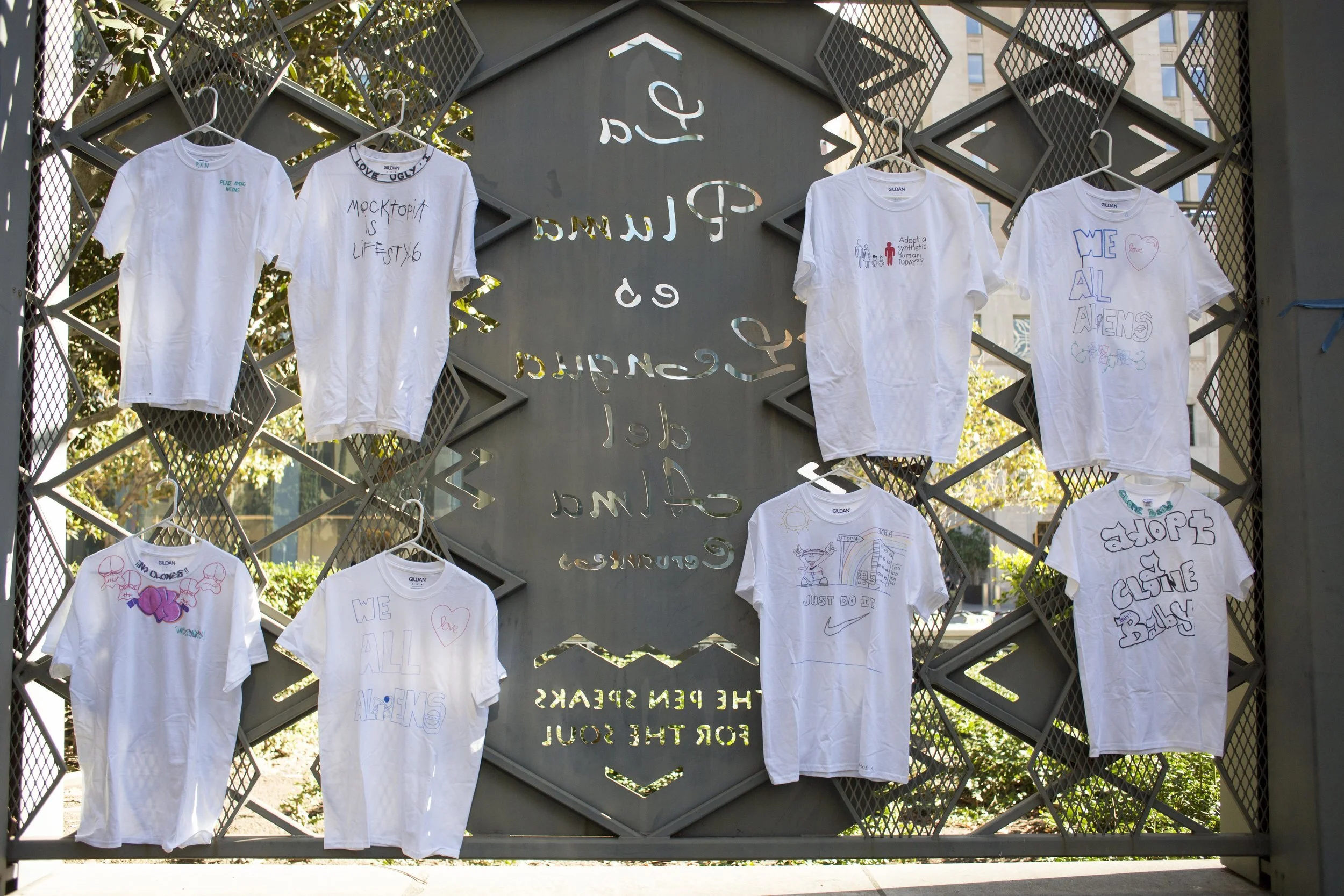

For the theme Into the Unknown: Sci-Fi Visions of the Future, we explored the concepts of future identities and our anxieties associated with technological advancement and modernity. We began by researching past, current, and future inventions and proceeded to design cybernetic enhancements for our mind, head, and senses. From our inventive 2D designs we modeled these in three dimensions using paper mâché. Inspired by Mary Shelley’s “Frankenstein” and through experimental approaches to art making, such as video projection mapping, we expanded our idea of what art could be by using our imagination, creativity, and problem solving facilities to realize our final collaborative installation. Throughout our creative journey, we explored the genre of science fiction in relationship to our current and future identities while considering the future boundaries of humanity when we begin to assimilate technology within our bodies.

For the theme Into the Unknown: Sci-Fi Visions of the Future, we explored the concepts of future identities and our anxieties associated with technological advancement and modernity. We began by researching past, current, and future inventions and proceeded to design cybernetic enhancements for our mind, head, and senses. From our inventive 2D designs we modeled these in three dimensions using paper mâché. Inspired by Mary Shelley’s “Frankenstein” and through experimental approaches to art making, such as video projection mapping, we expanded our idea of what art could be by using our imagination, creativity, and problem solving facilities to realize our final collaborative installation. Throughout our creative journey, we explored the genre of science fiction in relationship to our current and future identities while considering the future boundaries of humanity when we begin to assimilate technology within our bodies.


Students have looked at the history of Sci-fi in film, literature, inventions and in visual art through the artwork of artist Mahony Nagy. Following his philosophy to integrate art, technology and education for the betterment of humanity. We explored the value of new ways of seeing through technologies such as artificial intelligence and space photography from the Hubble.
Artworks were created with industrial materials such as plexiglass that was incised, painted and spray painted creating different forms and layers through stenciling.
Optical illusion, perspective and divine symmetry were introduced throughout this course in order to plan out the final composition.



The focus of our workshop was building a world of the future. We drew inspiration form artists across all mediums that created their own worlds within their work.
For example, our Infinity Box was inspired by Yayoi Kusama, an artist who creates life-size installation of outer space, inviting viewers into her own imagination. Each artist designed a pattern and created a stencil which they spray painted onto the outside of the Infinity Box as well as onto one globe which was installed inside the box, creating a universe made up of each artist's unique planets.
We also studied the concept of Afro Futurism, or science fiction that is centered on black narratives. Through examining the work of artists like Sun Ra, Parlament, Janelle Monae, Paradise Khanmalek, and the Black Panther film, each artist was asked to consider what kind of planet they would like to imagine. These planets were represented in our Tunnel Books, which were created using mixed media techniques.

The focus of our workshop was building a world of the future. We drew inspiration form artists across all mediums that created their own worlds within their work.
For example, our Infinity Box was inspired by Yayoi Kusama, an artist who creates life-size installation of outer space, inviting viewers into her own imagination. Each artist designed a pattern and created a stencil which they spray painted onto the outside of the Infinity Box as well as onto one globe which was installed inside the box, creating a universe made up of each artist's unique planets.
We also studied the concept of Afro Futurism, or science fiction that is centered on black narratives. Through examining the work of artists like Sun Ra, Parlament, Janelle Monae, Paradise Khanmalek, and the Black Panther film, each artist was asked to consider what kind of planet they would like to imagine. These planets were represented in our Tunnel Books, which were created using mixed media techniques.


Students have looked at the history of Sci-fi in film, literature, inventions and in visual art through the artwork of artist Mahony Nagy. Following his philosophy to integrate art, technology and education for the betterment of humanity. We explored the value of new ways of seeing through technologies such as artificial intelligence and space photography from the Hubble.
Artworks were created with industrial materials such as plexiglass that was incised, painted and spray painted creating different forms and layers through stenciling.
Optical illusion, perspective and divine symmetry were introduced throughout this course in order to plan out the final composition.


Students have looked at the history of Sci-fi in film, literature, inventions and in visual art through the artwork of artist Mahony Nagy. Following his philosophy to integrate art, technology and education for the betterment of humanity. We explored the value of new ways of seeing through technologies such as artificial intelligence and space photography from the Hubble.
Artworks were created with industrial materials such as plexiglass that was incised, painted and spray painted creating different forms and layers through stenciling.
Optical illusion, perspective and divine symmetry were introduced throughout this course in order to plan out the final composition.

Students have looked at the history of Sci-fi in film, literature, inventions and in visual art through the artwork of artist Mahony Nagy. Following his philosophy to integrate art, technology and education for the betterment of humanity. We explored the value of new ways of seeing through technologies such as artificial intelligence and space photography from the Hubble.
Artworks were created with industrial materials such as plexiglass that was incised, painted and spray painted creating different forms and layers through stenciling.
Optical illusion, perspective and divine symmetry were introduced throughout this course in order to plan out the final composition.


Students have looked at the history of Sci-fi in film, literature, inventions and in visual art through the artwork of artist Mahony Nagy. Following his philosophy to integrate art, technology and education for the betterment of humanity. We explored the value of new ways of seeing through technologies such as artificial intelligence and space photography from the Hubble.
Artworks were created with industrial materials such as plexiglass that was incised, painted and spray painted creating different forms and layers through stenciling.
Optical illusion, perspective and divine symmetry were introduced throughout this course in order to plan out the final composition.




Japanese American National Museum | Monuments and Memory: Reconstructing American History
Photos by Las Fotos and Paul Ulukpo
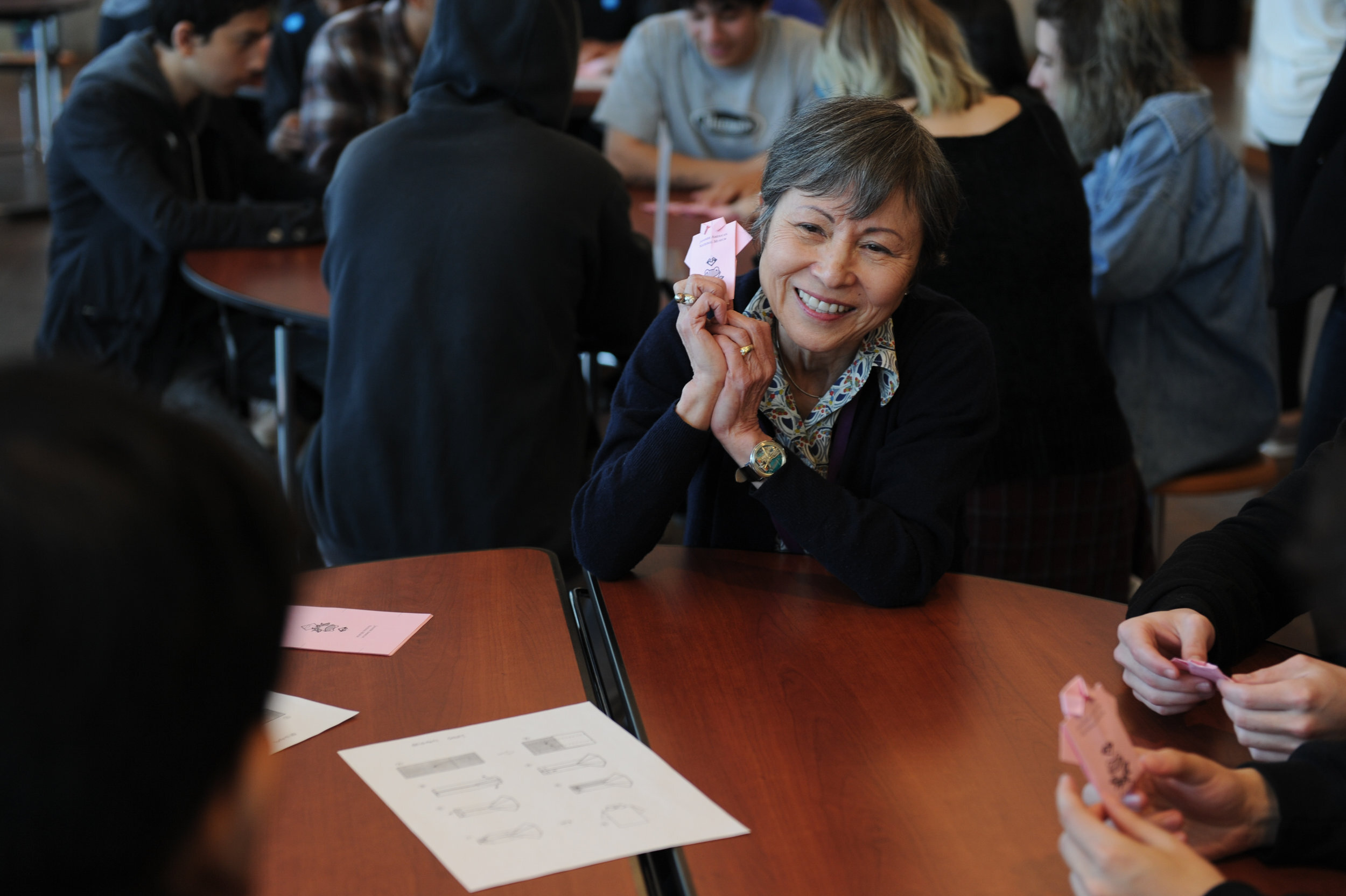
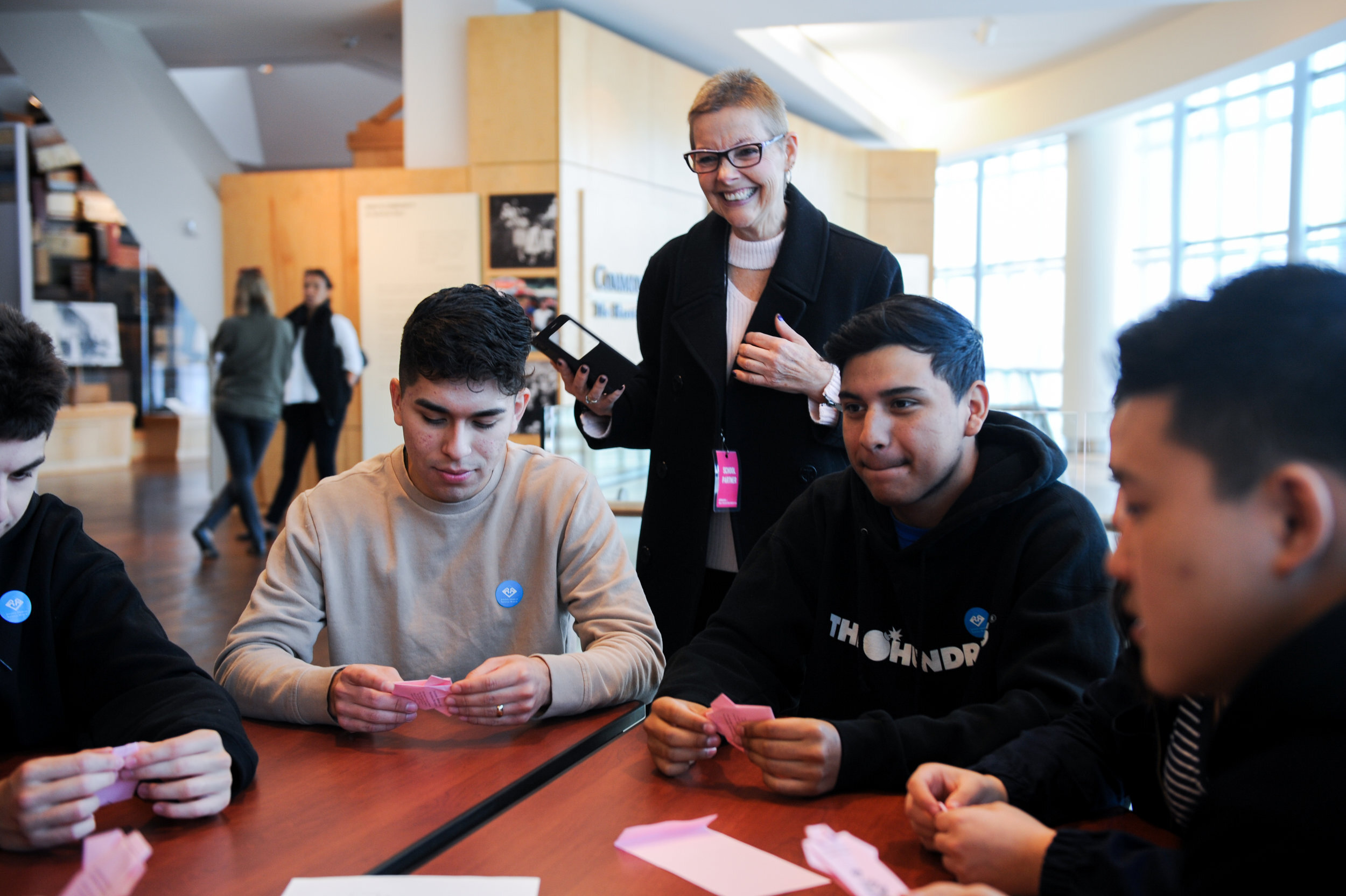
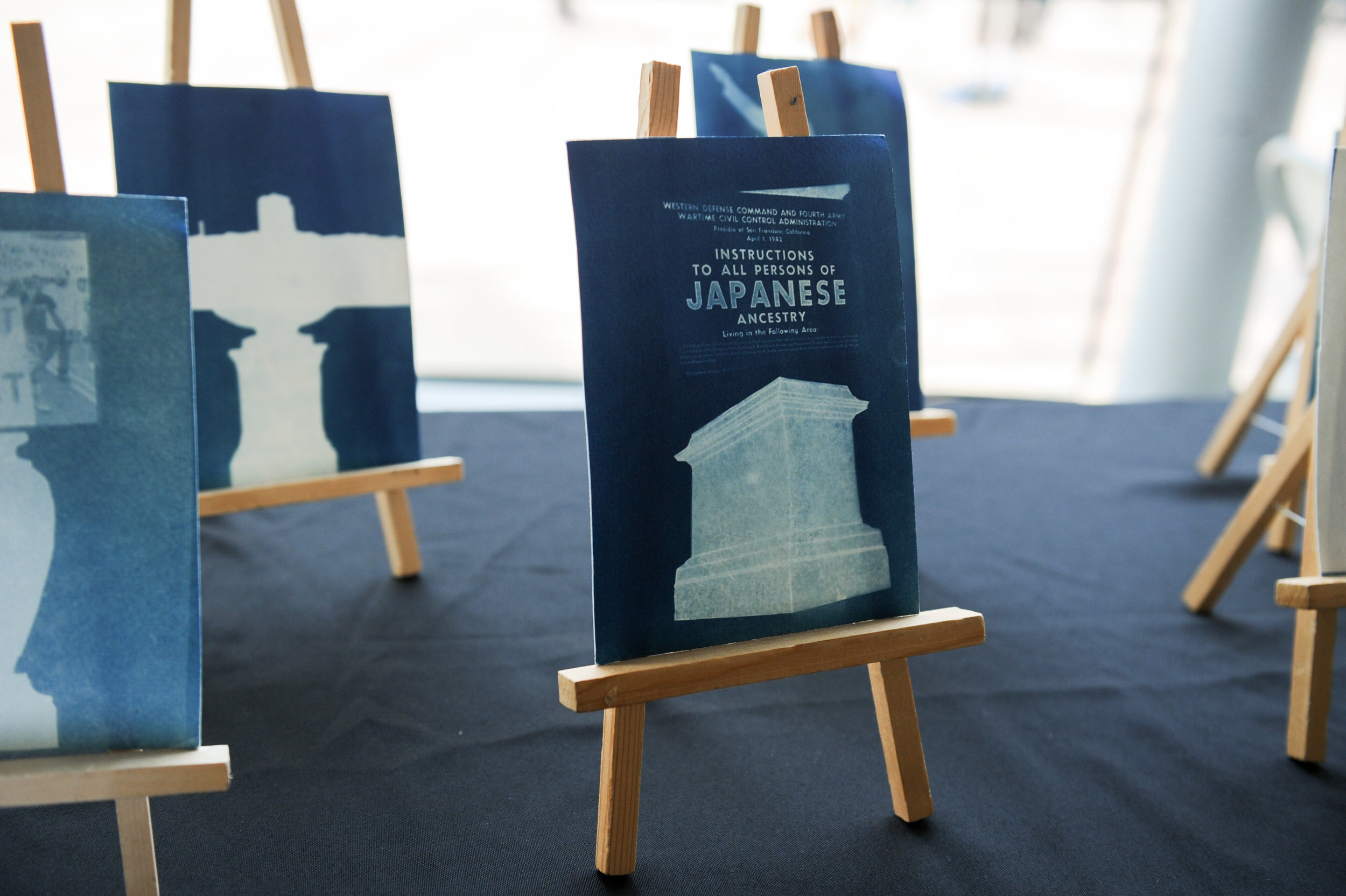
As we learned about the Japanese Internment camps, we reflected on our own family histories that could be memorialized or honored. Students delved into family stories and created memorial cups to honor these stories; stories that helped shape how they see themselves. One story, the Manzanar Historic site had to be fought for by its survivors and family members, so that history would not be forgotten. We too, memorialize an action of personal significance in connection to our stories of survival and triumph. We used a photo composite to capture the essence of these memories. Students sketched out a composition with elements of their story where they incorporated themselves. They shot self-portraits around the school to use in these compositions. Using this portrait, family pictures, landscapes, and other elements they brought the story together digitally in Photoshop Elements.

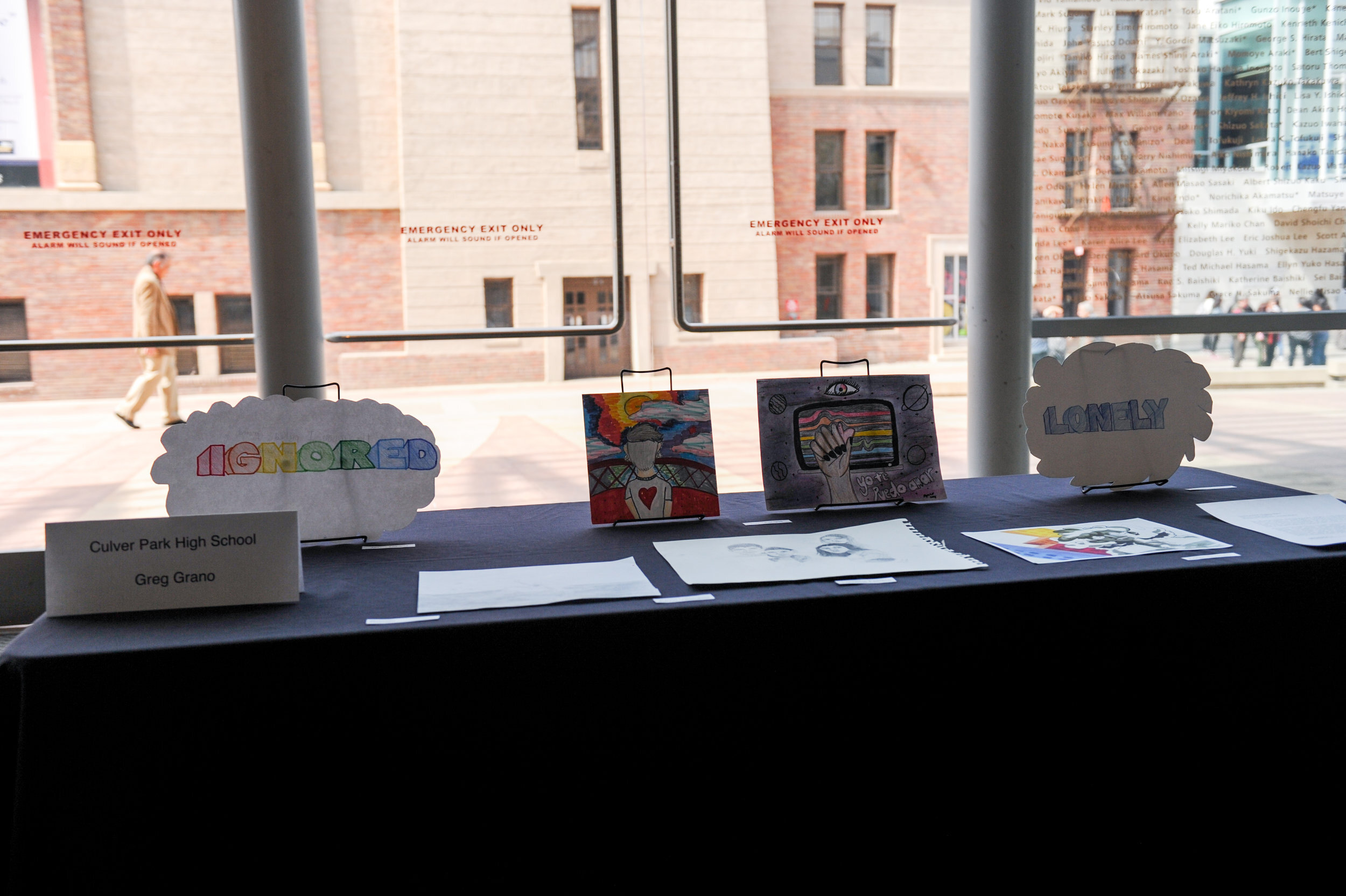
How do stories change when the storyteller changes? In this workshop, students will explore the power behind storytelling through discussion and creative expression. We will look at America’s concentration camps for Japanese Americans during World War II and ask critical questions: what stories did the US government tell about Japanese Americans? What stories have been told from members of that community? And how do we see multiple storytellers at work in our own lives?
In the first three weeks of our ten-week workshop, we will explore these questions through several artistic activities focused on personal reflection. Then, students will collaborate on a documentary video installation to display at the Public Presentation at JANM that explores the central themes of identity, discrimination, and the power of storytelling. Students will work in small teams to contribute to the video production and visual art components, offering a variety of opportunities to engage as artists. By the end of this workshop, students will have a foundational understanding of documentary filmmaking and the power of using their voice in story telling.
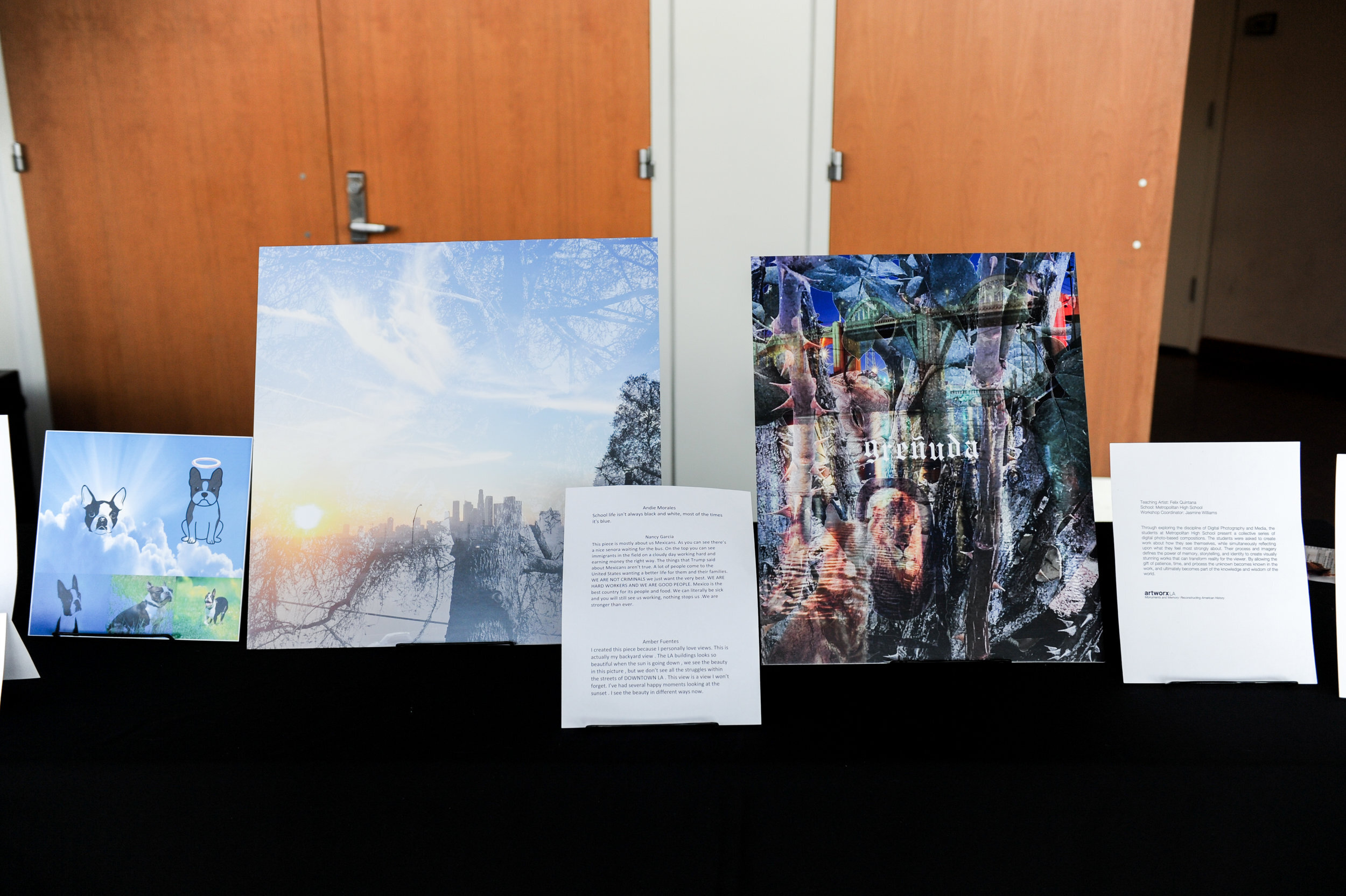
Through exploring the discipline of Digital Photography and Media, the students at Metropolitan High School present a collective series of digital photo-based compositions. The students were asked to create work about how they see themselves, while simultaneously reflecting upon what they feel most strongly about. Their process and imagery defines the power of memory, storytelling, and identity to create visually stunning works that can transform reality for the viewer. By allowing the gift of patience, time, and process the unknown becomes known in the work, and ultimately becomes part of the knowledge and wisdom of the world.
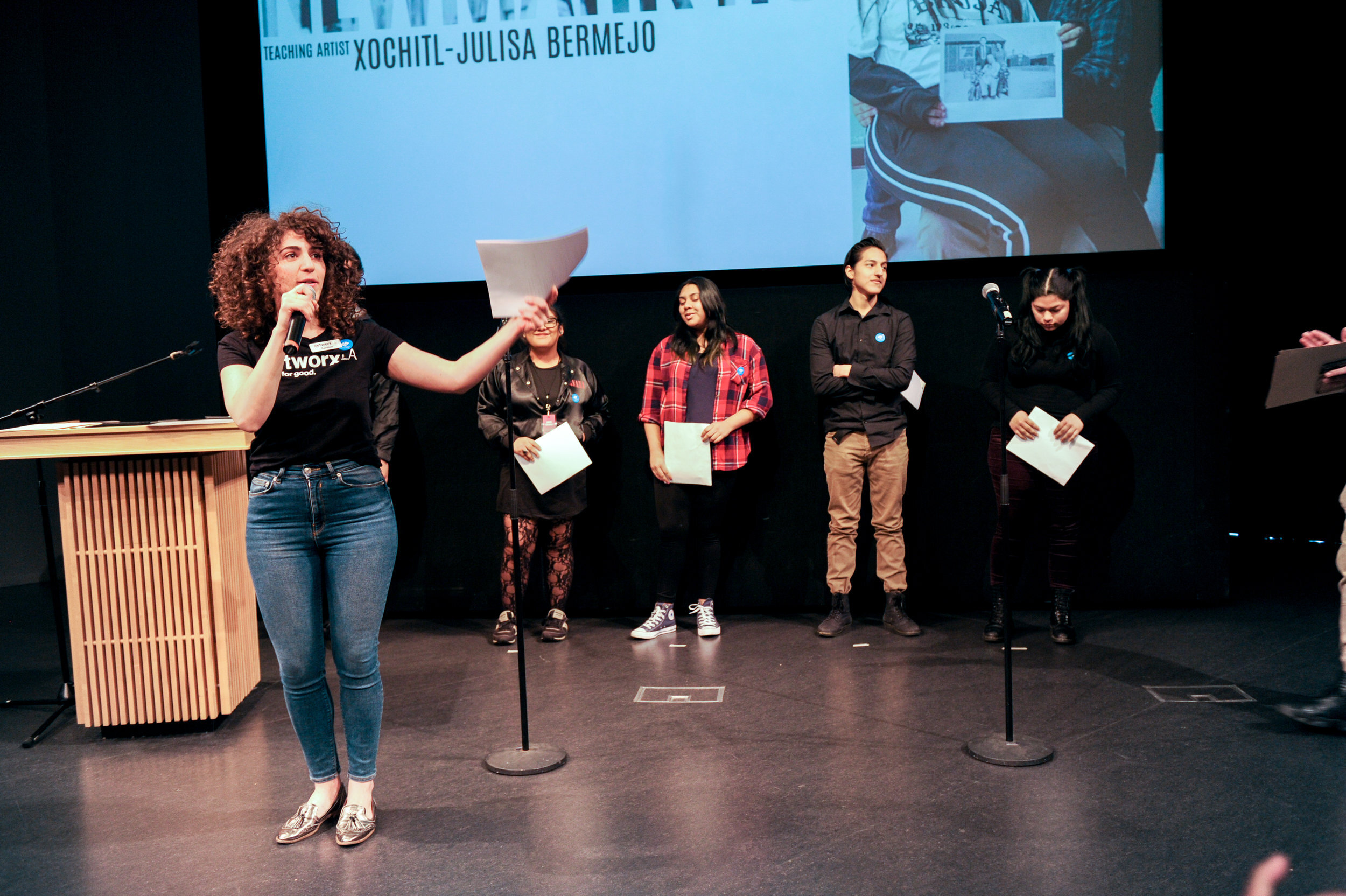
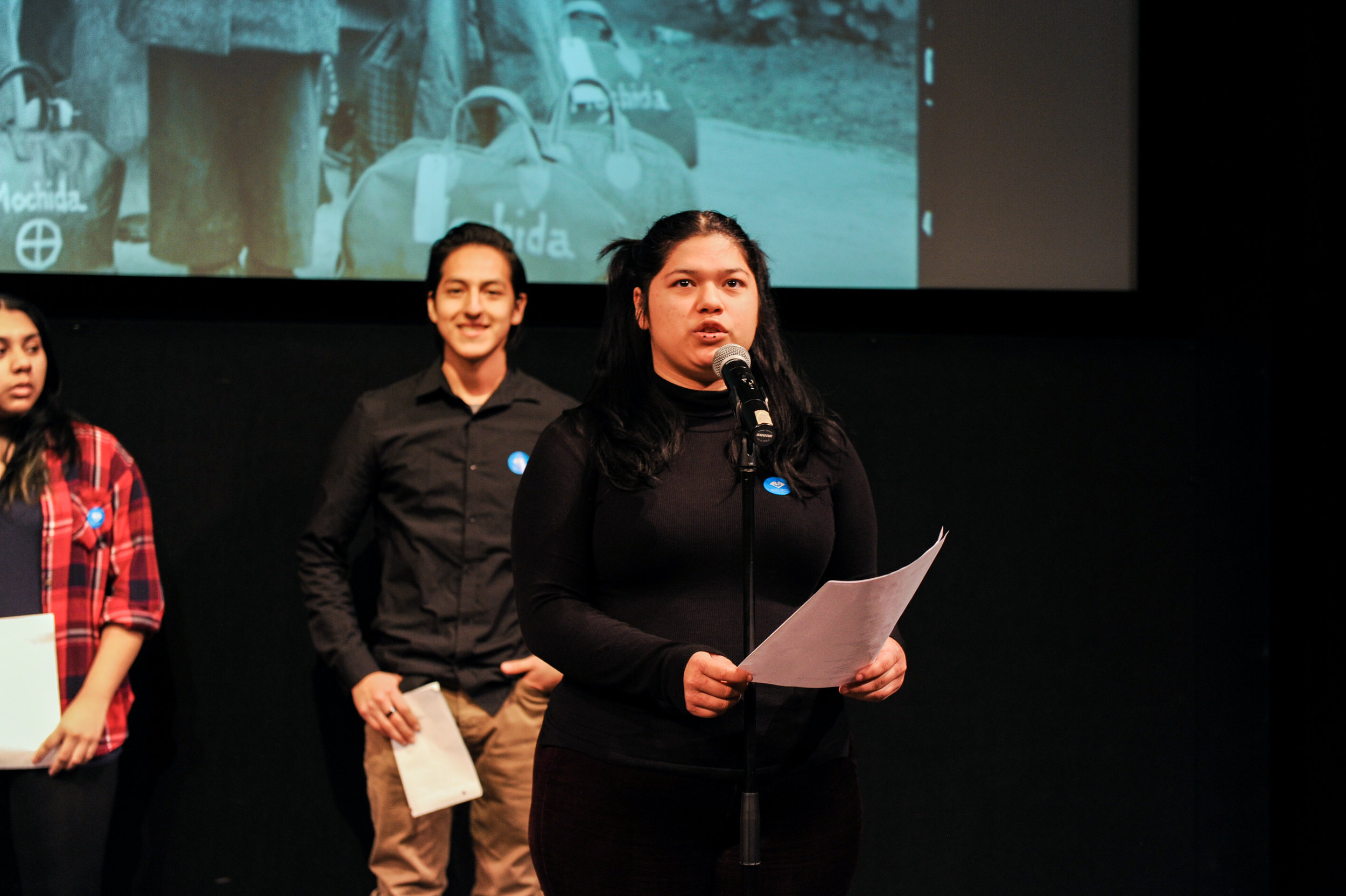
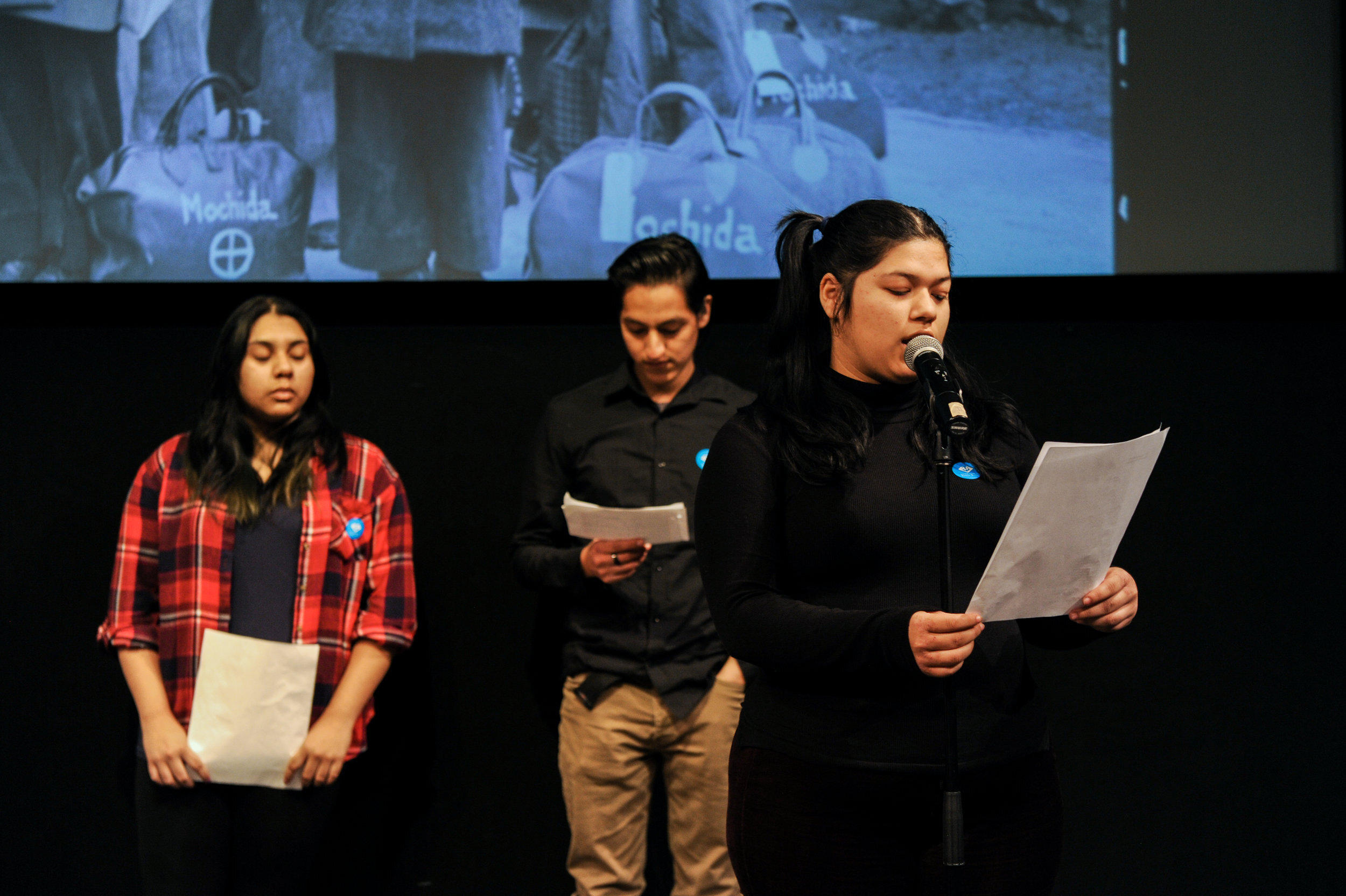
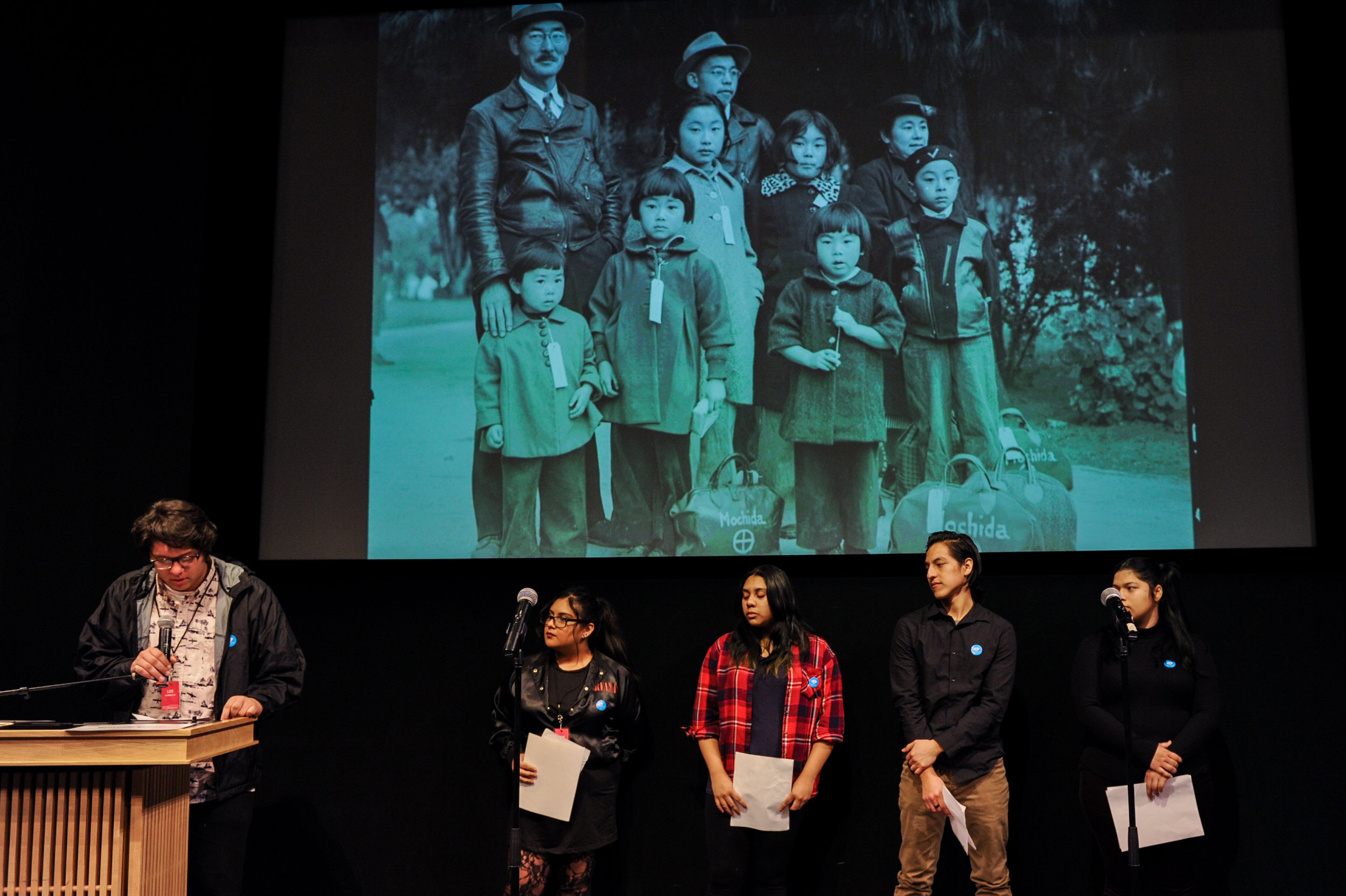
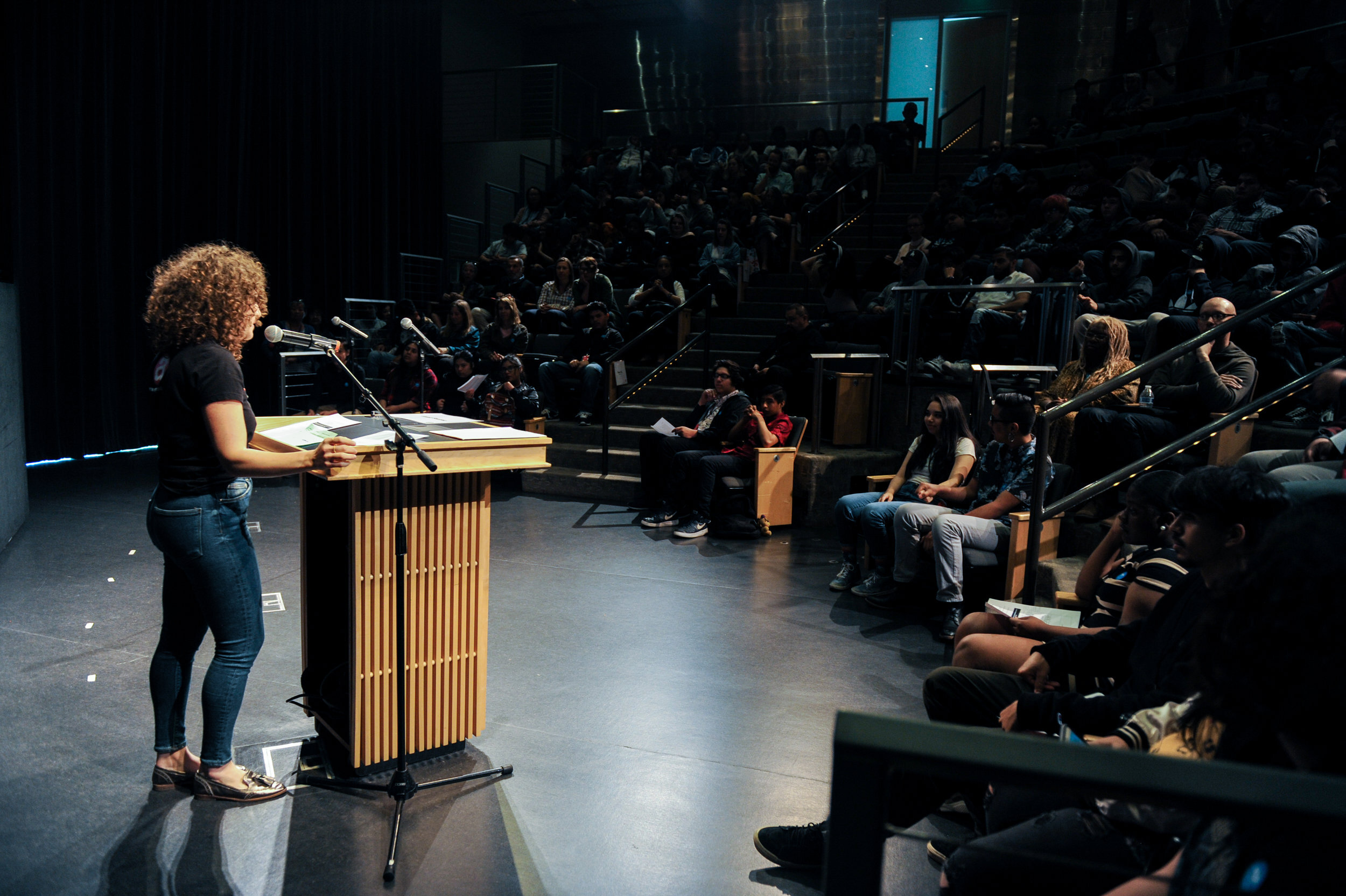
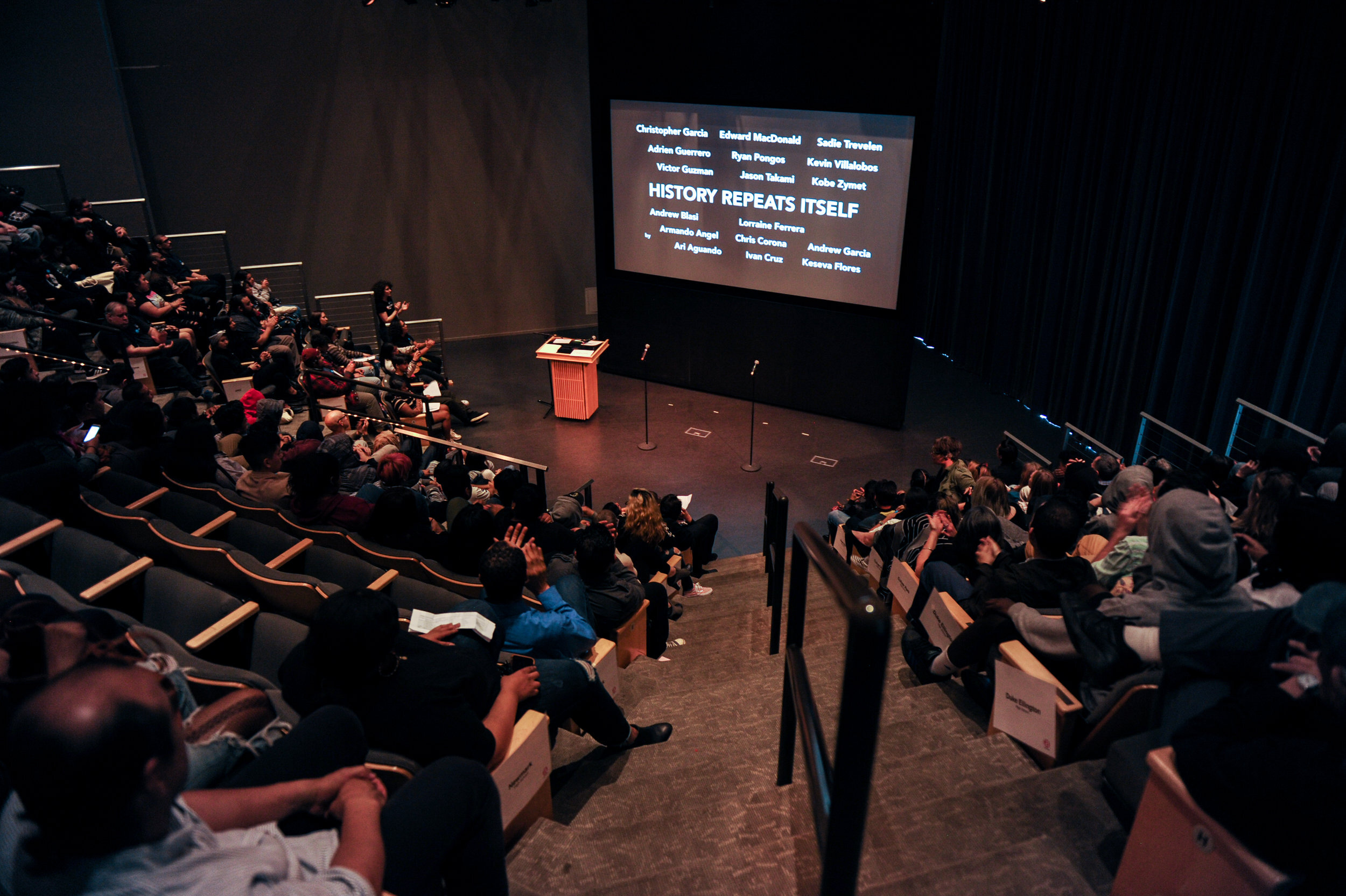
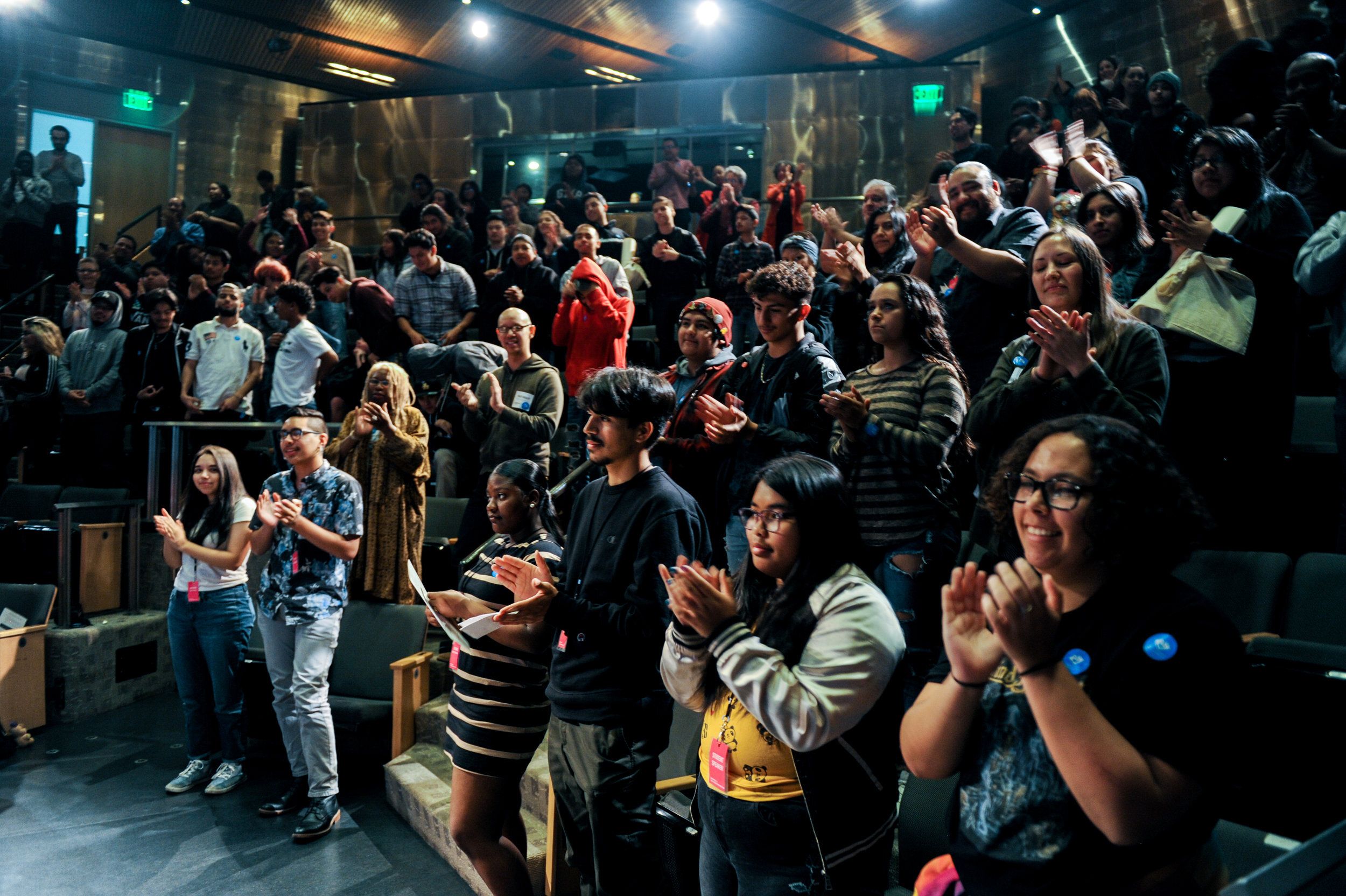
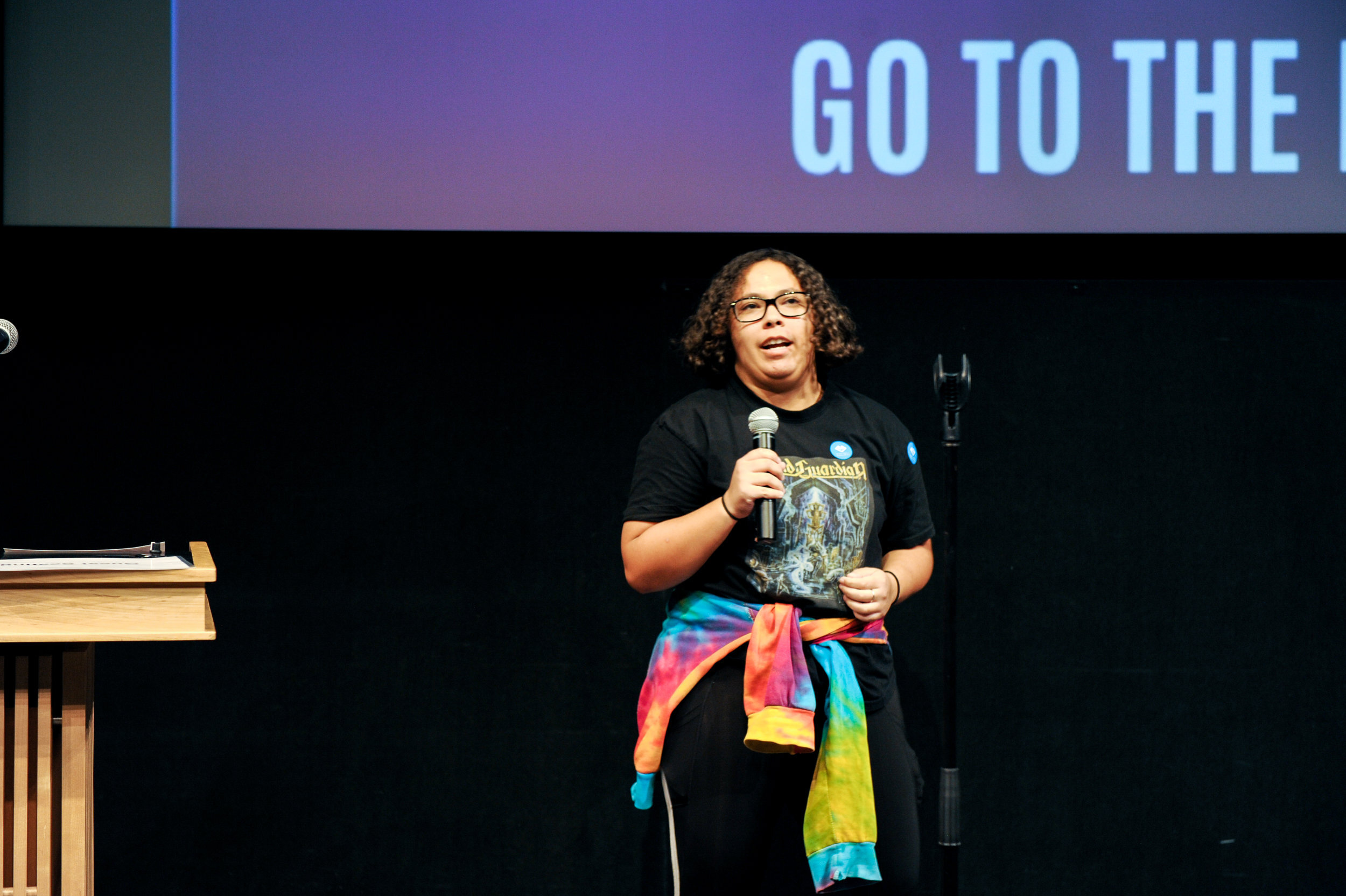
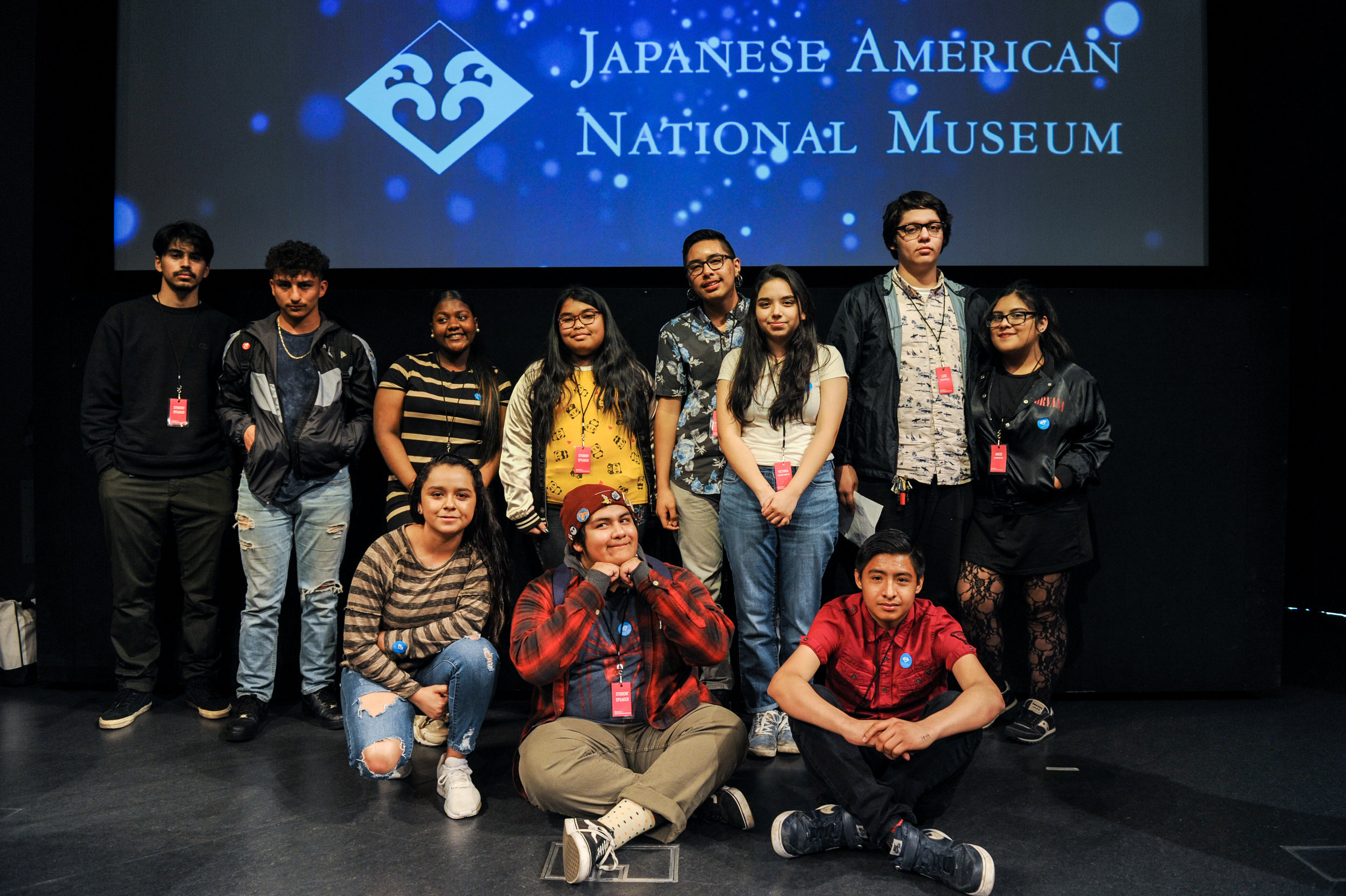
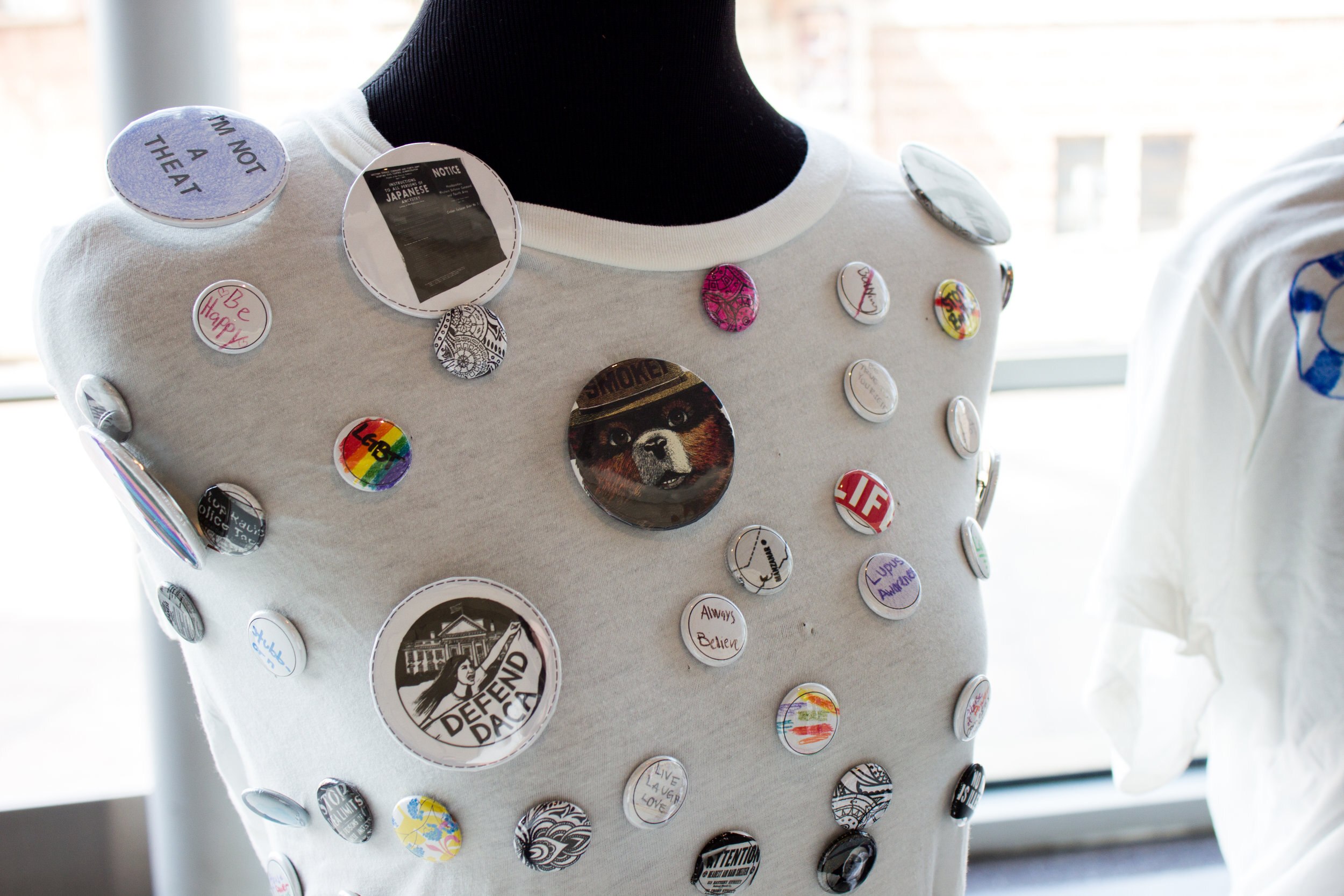
Students at Cesar Chavez Continuation High School explored the theme of Monuments and Memory, commemorating the 75th anniversary of the Japanese Internment, by making souvenirs expressing ideas, people and events that they think are important to remember. During the workshop, students learned how to make pin-back buttons, sublimation printed mugs and sun-printed postcards. We considered questions such as: What is a monument? What does it mean to commemorate and whose story gets told? How do the objects around you and the things you wear tell a story about you? What does empowerment mean and how can you “reclaim” history?
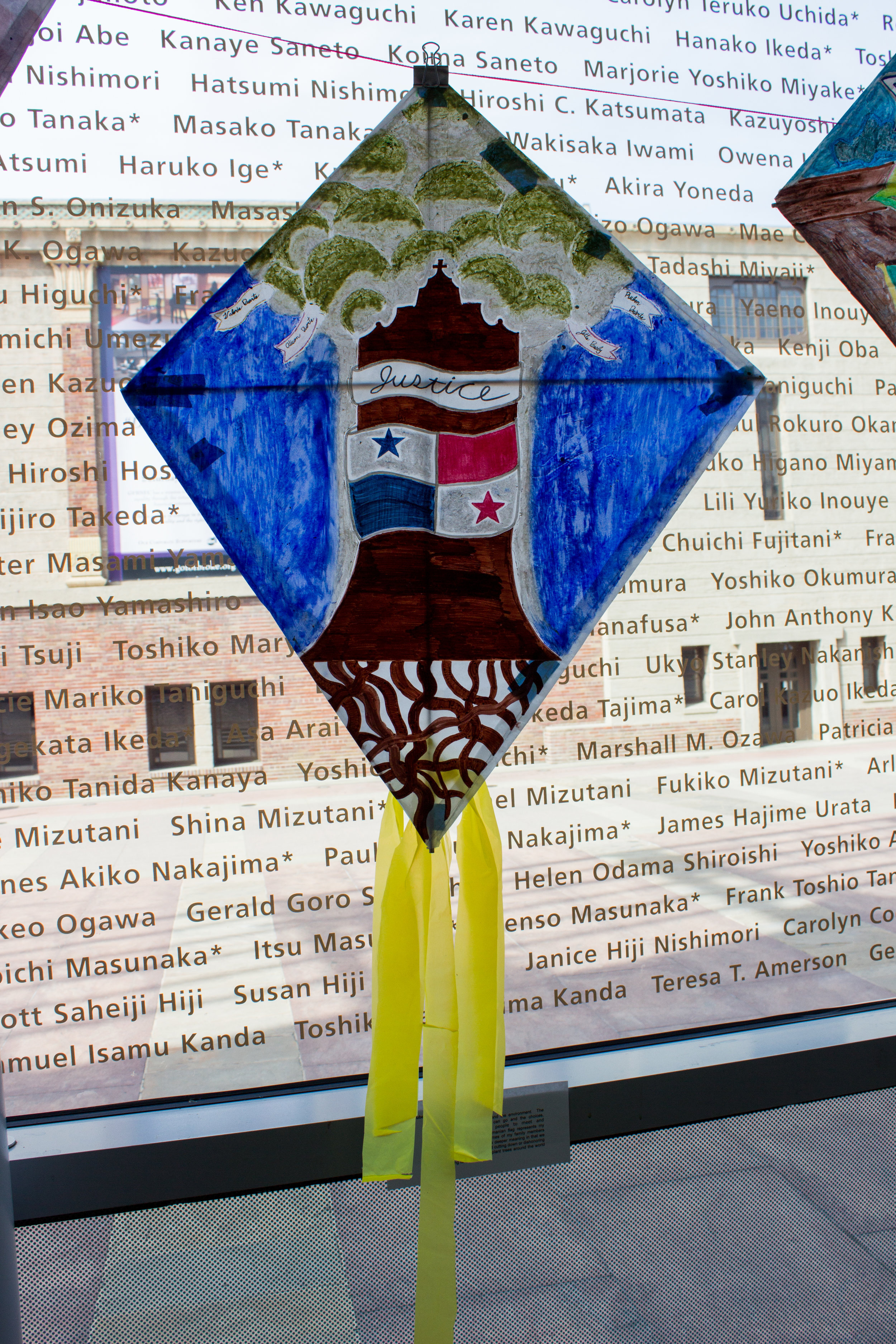
What is a monument? How can the form of a monument be symbolic? How can a monument speak out against injustice? These are the driving questions students considered throughout our workshop. Students looked at monuments commemorating Japanese American incarceration during World War II as a means to access collective memory and personal stories. Together, we explored reasons for commemorating difficult histories.
With that as inspiration, students engaged in a design process that began with thinking about the function of a monument, brainstorming about significantly meaningful experiences in their own lives, and ultimately creating visuals to communicate personal history and oppose injustices. Their personal monuments take on the form of a mixed media kite. The kites are functional and can fly, adding to their symbolism of overcoming injustice, freedom, and soaring above trauma. Through these kites-monuments, students will launch their hopes and honor their own history.

From 1942 to 1945 LA’s Little Tokyo became an African-American community known as Bronzeville. Executive Order 9066 forced thousands of Japanese-Americans from their homes and into concentration camps during 1942. Around the same period Southern African-Americans began migrating to Los Angeles for wartime jobs but they were restricted from living in most LA neighborhoods. Soon they began moving into the vacant storefronts and homes left behind by the Japanese. Bronzeville’s population increased to more than 50,000 and became a mecca for black owned stores, restaurants, hotels and jazz clubs. Shepp’s Playhouse at 1st Street and Los Angeles was a hotspot for musicians Miles Davis, Charlie Parker and gangster Micky Cohen.
This little known history, coupled with the tragedy of Japanese internment led students to related explorations of injustice, discrimination and illegal actions by those in power. They responded to challenging questions about love and survival in contemporary times as unarmed black men lost their lives daily. This memorial tree contains images of African-Americans, Bronzeville life, Japanese-American citizens, quotations, and markers dedicated to Native American and Latino victims of injustice. Surrounding paper chains are imprinted with names of unarmed Black people killed by police, and names of imprisoned Japanese-Americans.
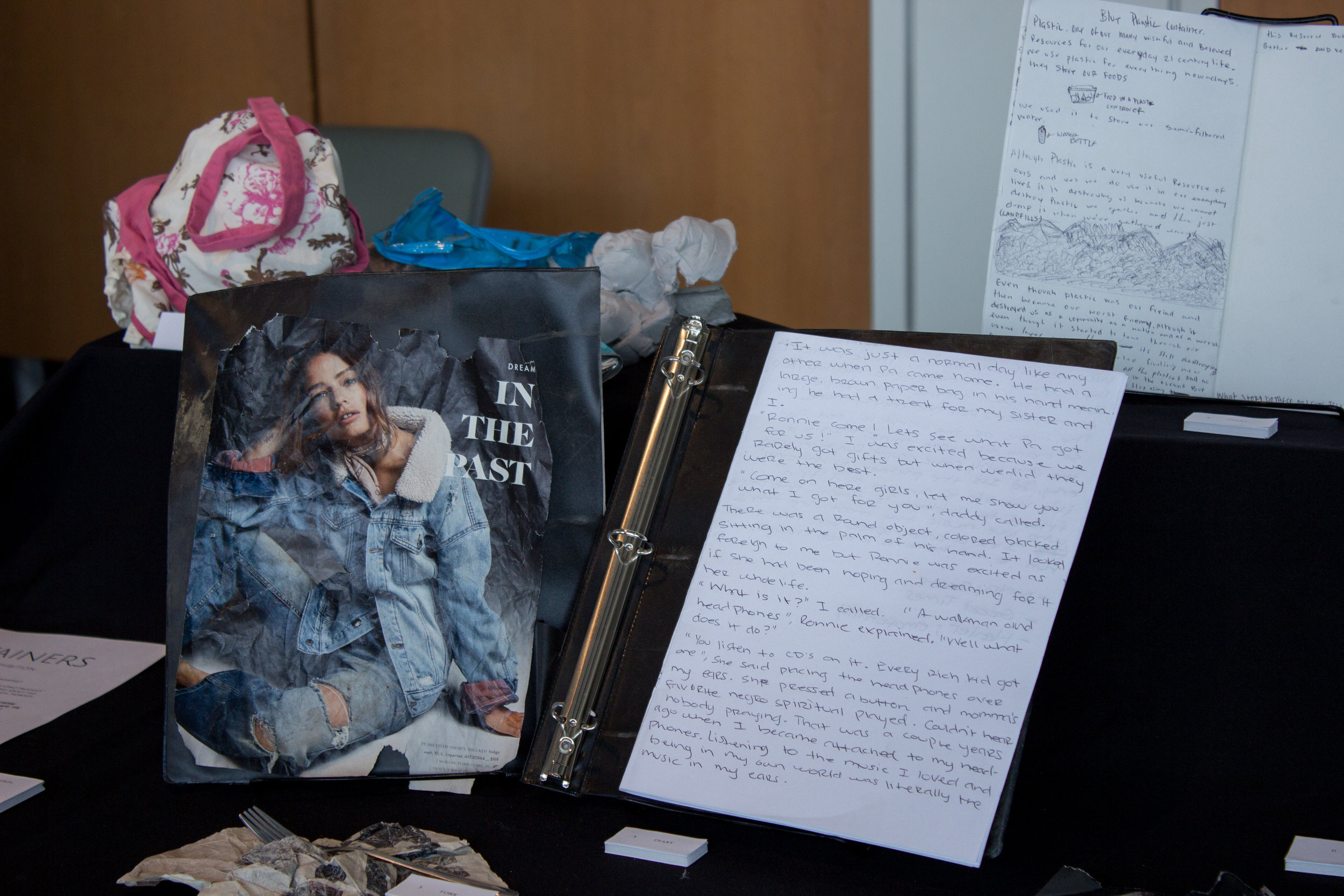
This workshop examined narrative and its construction as a monument to the ideals, values, and principles a culture strives to memorialize. Examining various forms of narrative such as poetry, historical accounts, monologue, visual storytelling, exhibitions, and prose, we have drawn parallels between the creation of a story and the construction and life of a monument. Students considered questions of authorship, translation, and prevalence of a given narrative as well as preservation or loss of information in relationship to the reader’s experience of a story and the monumental implications that narrative has on cultural memory. Students simultaneously examined existing cultural narratives, including several that were connected with Japanese internment in the United States during WWII.
With narrative construction as our conceptual lens for monument study over the past ten weeks, students have been asked to examine what constitutes a monument and its legacy, both personal and cultural, and why that is relevant to understanding what and how we remember the things we memorialize as a culture today. Our class was challenged to consider their own lives and culture as history in the making and to question what objects, ideas, and stories they hope to preserve for future generations. Using the practical skills and critical thinking they’ve developed, our class designed a museum of the future that constructs a narrative of life in 2018 through the arrangement of objects, images, and information with a profound focus on the importance of storytelling to memorialize our histories and their personal and/ or cultural significance.
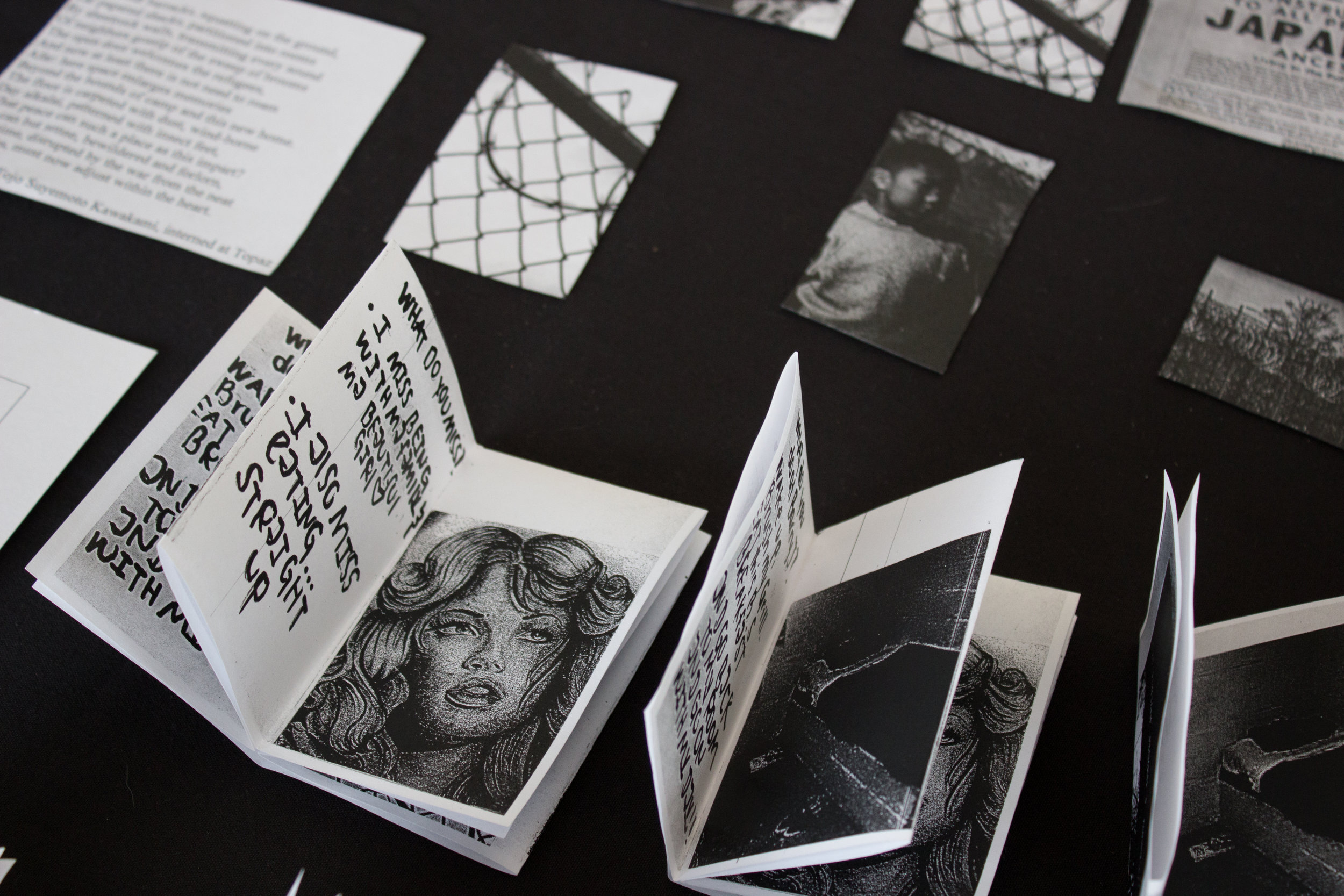
Inspired by letters from the Japanese American internment camps, students from Barry J Nidorf Juvenile Hall were encouraged to share their own stories of incarceration through original songs, blackout poems and zines. Over the course of ten sessions, students learned how to use the Ableton Push MIDI controller to make their own samples and beats. Reading through the Miss Breed letters, students compared and contrasted their lives with the lives of interned Japanese American youth. These letters also served as a source for blackout poems that highlight shared experiences. Lastly, students created zines with images, drawings, and text that speak to their everyday lives, their rooms, meals and daily routines.
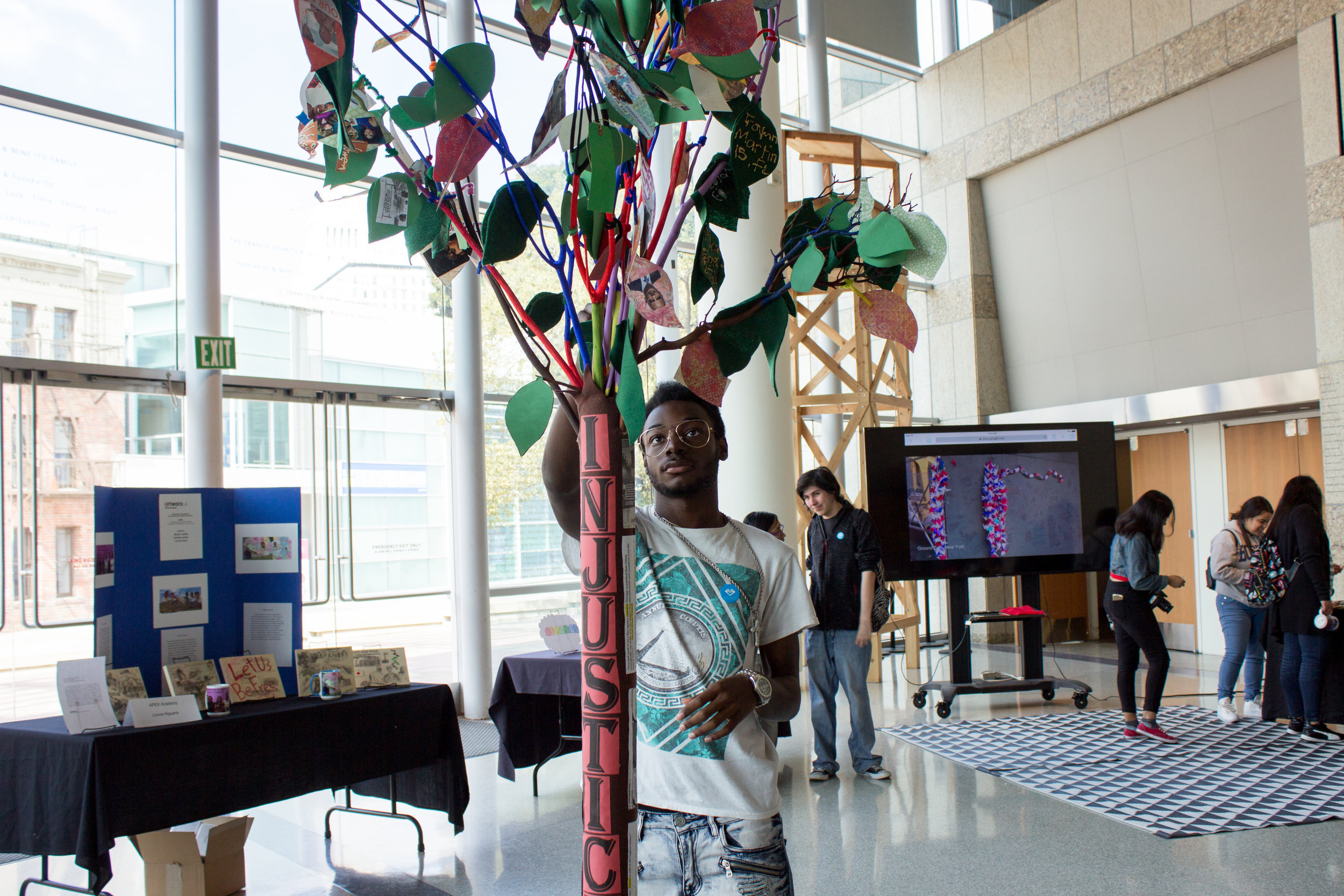
From 1942 to 1945 LA’s Little Tokyo became an African-American community known as Bronzeville. Executive Order 9066 forced thousands of Japanese-Americans from their homes and into concentration camps during 1942. Around the same period Southern African-Americans began migrating to Los Angeles for wartime jobs but they were restricted from living in most LA neighborhoods. Soon they began moving into the vacant storefronts and homes left behind by the Japanese. Bronzeville’s population increased to more than 50,000 and became a mecca for black owned stores, restaurants, hotels and jazz clubs. Shepp’s Playhouse at 1st Street and Los Angeles was a hotspot for musicians Miles Davis, Charlie Parker and gangster Micky Cohen.
This little known history, coupled with the tragedy of Japanese internment led students to related explorations of injustice, discrimination and illegal actions by those in power. They responded to challenging questions about love and survival in contemporary times as unarmed black men lost their lives daily. This memorial tree contains images of African-Americans, Bronzeville life, Japanese-American citizens, quotations, and markers dedicated to Native American and Latino victims of injustice. Surrounding paper chains are imprinted with names of unarmed Black people killed by police, and names of imprisoned Japanese-Americans.
artworxLA Level 1 program brings arts education to schools in LA County during the academic year. Students in Level 1 classroom workshops participate in three 11-week workshops each year. Professional artists guide students to create art that connects to exhibitions and programs at museums, theaters, civic, and cultural centers. Each 11-week workshop culminates in a trip to the institution, where students present their final work.
artworxLA is part of the 2018 Juvenile Justice Art Project. The Juvenile Justice Art Project is a partnership between the County of Los Angeles Probation Department, the Los Angeles County Arts Commission and the Arts for Incarcerated Youth Network.

